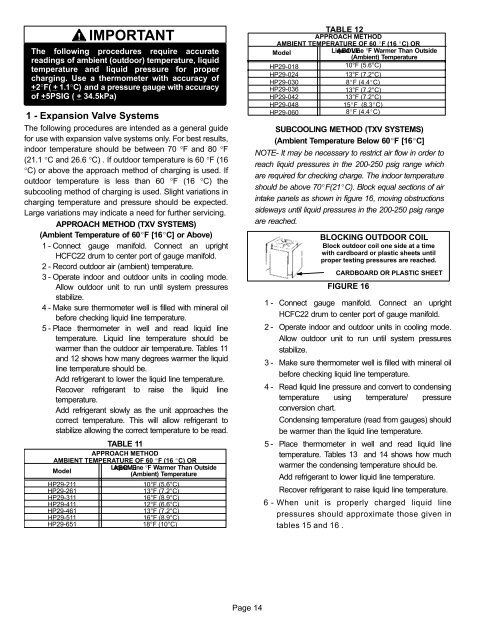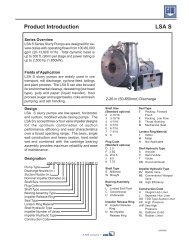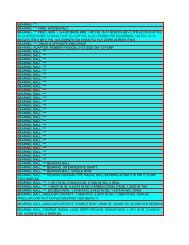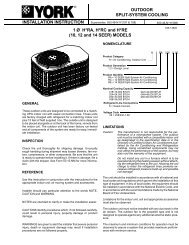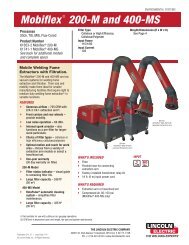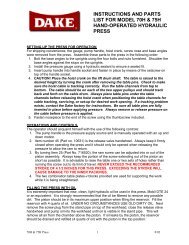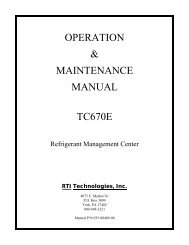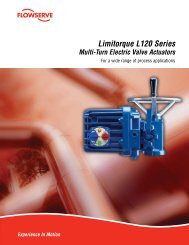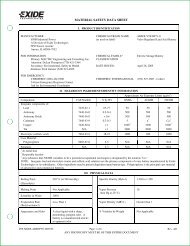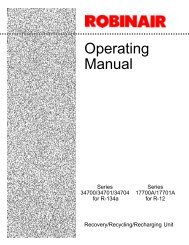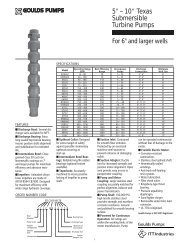Lennox HP29
Lennox HP29
Lennox HP29
You also want an ePaper? Increase the reach of your titles
YUMPU automatically turns print PDFs into web optimized ePapers that Google loves.
IMPORTANTThe following procedures require accuratereadings of ambient (outdoor) temperature, liquidtemperature and liquid pressure for propercharging. Use a thermometer with accuracy of+2°F( + 1.1°C) and a pressure gauge with accuracyof +5PSIG ( + 34.5kPa)1 − Expansion Valve SystemsThe following procedures are intended as a general guidefor use with expansion valve systems only. For best results,indoor temperature should be between 70 °F and 80 °F(21.1 °C and 26.6 °C) . If outdoor temperature is 60 °F (16°C) or above the approach method of charging is used. Ifoutdoor temperature is less than 60 °F (16 °C) thesubcooling method of charging is used. Slight variations incharging temperature and pressure should be expected.Large variations may indicate a need for further servicing.APPROACH METHOD (TXV SYSTEMS)(Ambient Temperature of 60F [16C] or Above)1 − Connect gauge manifold. Connect an uprightHCFC22 drum to center port of gauge manifold.2 − Record outdoor air (ambient) temperature.3 − Operate indoor and outdoor units in cooling mode.Allow outdoor unit to run until system pressuresstabilize.4 − Make sure thermometer well is filled with mineral oilbefore checking liquid line temperature.5 − Place thermometer in well and read liquid linetemperature. Liquid line temperature should bewarmer than the outdoor air temperature. Tables 11and 12 shows how many degrees warmer the liquidline temperature should be.Add refrigerant to lower the liquid line temperature.Recover refrigerant to raise the liquid linetemperature.Add refrigerant slowly as the unit approaches thecorrect temperature. This will allow refrigerant tostabilize allowing the correct temperature to be read.TABLE 11APPROACH METHODAMBIENT TEMPERATURE OF 60 F (16 C) ORLiquid ABOVE Line °F Warmer Than OutsideModel(Ambient) Temperature<strong>HP29</strong>−21110°F (5.6°C)<strong>HP29</strong>−26113°F (7.2°C)<strong>HP29</strong>−31116°F (8.9°C)<strong>HP29</strong>−41112°F (6.6°C)<strong>HP29</strong>−46113°F (7.2°C)<strong>HP29</strong>−51116°F (8.9°C)<strong>HP29</strong>−65118°F (10°C)TABLE 12APPROACH METHODAMBIENT TEMPERATURE OF 60 F (16 C) ORModelLiquid ABOVE Line °F Warmer Than Outside(Ambient) Temperature<strong>HP29</strong>−01810°F (5.6°C)<strong>HP29</strong>−02413°F (7.2°C)<strong>HP29</strong>−0308F (4.4C)<strong>HP29</strong>−03613°F (7.2°C)<strong>HP29</strong>−04213°F (7.2°C)<strong>HP29</strong>−04815F (8.3C)<strong>HP29</strong>−0608F (4.4C)SUBCOOLING METHOD (TXV SYSTEMS)(Ambient Temperature Below 60F [16C]NOTE- It may be necessary to restrict air flow in order toreach liquid pressures in the 200-250 psig range whichare required for checking charge. The indoor temperatureshould be above 70F(21C). Block equal sections of airintake panels as shown in figure 16, moving obstructionssideways until liquid pressures in the 200-250 psig rangeare reached.BLOCKING OUTDOOR COILBlock outdoor coil one side at a timewith cardboard or plastic sheets untilproper testing pressures are reached.CARDBOARD OR PLASTIC SHEETFIGURE 161 − Connect gauge manifold. Connect an uprightHCFC22 drum to center port of gauge manifold.2 − Operate indoor and outdoor units in cooling mode.Allow outdoor unit to run until system pressuresstabilize.3 − Make sure thermometer well is filled with mineral oilbefore checking liquid line temperature.4 − Read liquid line pressure and convert to condensingtemperature using temperature/ pressureconversion chart.Condensing temperature (read from gauges) shouldbe warmer than the liquid line temperature.5 − Place thermometer in well and read liquid linetemperature. Tables 13 and 14 shows how muchwarmer the condensing temperature should be.Add refrigerant to lower liquid line temperature.Recover refrigerant to raise liquid line temperature.6 − When unit is properly charged liquid linepressures should approximate those given intables 15 and 16 .Page 14


